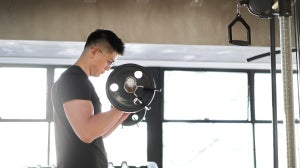
Professional athletes have a whole host of advantages that you and I can only dream of, from a genetic superiority to their ability to train 5 hours a day under supervised conditions.
We want to level the playing field, and using these 5 methods that the very top players in the world follow, you can change the way you train forever.
What You Need To Do
- Follow a training plan
- Periodise your training
- Train your whole body
- Work on your weaknesses
- Record what you’re doing

1. Follow a training plan
Rugby is a hard, physical game. For you to be able to compete at your very best, your body must not only be able to survive the onslaught of a rugby game, but it must be able to excel in it.
The difference between good and great players is often their ability to impose themselves on the game. There are so many skilful players out there that to stand out you need to be fitter, stronger and faster than your opposition. Because of this, physical development is as if not more important than skill development.
To develop to the peak of your ability, it is essential that you follow a structured training plan. Just wandering into the gym and doing what you feel like every time isn’t enough. Find a structured, balanced program to follow and stick to it
Far too many people will start a new program and give up before you have a chance to see any real results. You have a full pre-season do develop as much power strength and cardiovascular fitness as you can without having to worry about recovering in time for games, so make the most of it. See your program until the end and reap the rewards.

2. Periodise your training
Rather than trying to progress all aspects of performance at once and wearing yourself out. The professionals focus all of their energy on progressing one aspect of fitness while simply maintaining the others.
Periodisation is a deep rabbit hole so I’ll just give you what you need to know! For rugby you have 2 main training periods, pre-season and in-season. In-season you will be concentrating on performing at your best on game day, and your training should be geared towards that. Pre- season is where the magic happens. This is where you really work to get bigger faster stronger.
If you have a 12 week long pre- season, split it into 3, 4 week blocks and focus on the 3 main areas you want to work on. Let’s say cardiovascular fitness, strength and power. Order them by how long the effects of the training last, as your aim is to be at peak performance by the beginning of the season. In this case: the effects of cardiovascular training last the longest, then strength, then power so complete your 3 blocks in that order. The gains you made in fitness should be able to last long enough to still be there as the season starts.
In each of these blocks, you will focus on improving the main aspect of fitness for the block, and maintain the others. For example: training 4 times per week in the strength block, you would complete two full sessions dedicated to strength in which you would strive for improvement, and a session each for cardiovascular fitness and power in which you will work to maintain the levels you have already obtained.
By focusing on one aspect at a time in this way, you will ensure the maximum progress is not only made, but maintained.

3. Train your whole body
If you want to be a bodybuilder, then training with body part splits if fine. But to provoke the greatest transfer between your training and on field performance, specificity is key. You want your training to be as close to the demands of a rugby game as possible, while maintaining effective training practice.
It is extremely rare for you to be using one body part isolated from the rest of the body during a game of rugby. The sport requires full body movements in which your muscles work together perfectly in sync, generating as much force as possible, efficiently as possible.
Because of this, within each training session the whole body should be trained.
Your training sessions should be structured so that:- Upper and lower body is trained.
- Push and pull exercises are both used
- Compound (multi muscle, multi joint) exercises are used
- Big muscle groups are trained before small muscle groups (legs before arms)
- Energy systems are trained separately (power training isn’t mixed with long slow runs)
A simple strength workout might look like:
Back Squat – 6x4Romanian Deadlift – 6x4Bench Press – 6x4Barbell Row – 6x4Shoulder Press – 6x4Parallel Bar Dips – 6x4
To save time, you could superset opposing muscle group exercises such as bench press and barbell row, or shoulder press and parallel bar dips, so one muscle group has time to recover as the other one works.
Leave ‘guns day’ as a special treat, or add exercises for muscles you want to develop additionally on to the end.

4. Work on your weaknesses
Take it from a guy who sustained a career-ending injury: you need to be doing everything you can to prevent injuries. Rugby is a tough sport and contact injuries are always going to happen, but you must do everything you can to minimise the risk of non-contact injuries, such as pulled or torn muscles.
The first key way you can do this, is train all muscle groups evenly. As I touched on in ‘train your whole body’ you cannot simply focus on the muscles you like to train, like chest for example. You must also train your back otherwise muscle imbalances will start to form.
Muscle imbalances in one muscle will eventually slow down the growth of the opposite muscle, as both sides of the pair will work during the movement. Using our example, when your chest contracts to push, your back will work to control the movement. If your back isn’t strong enough, your chest will stop developing as you want it to, and your back will become susceptible to injury as it isn’t able to keep up with the demands you are placing on it.

Classically undertrained muscle groups are hamstrings, back and triceps. Don’t ignore them.
In addition to your main exercise, it is important to do additional exercises to work on the little, often ignored muscles. With all of the contact on your shoulder joints, any weakness can easily be exposed leading to injury so it is vital that your rotator cuff muscles are able to keep up with the development of the rest of your body.
You can put add-on’s at the start or the end of the session such as overhead reverse lunges, band walks and resisted external interior and exterior rotations for the rotator cuff.
5. Record what you’re doing
At the top level, performance is a science. There is no room for guesswork. So when it is possible, everything must be tracked.
In my experience, top level professional rugby players rate their sleep each night, how sore they are, how hard they worked in training, how good they are feeling, and what weight they are lifting.
Tracking factors that affect performance is more than simply data collection. Tracking will improve adherence to a program, it will act as a constant reminder of your goal and it will allow you to make informed decisions on your training.
If you are seeing a plateau in muscle gain, you can look back at what you are eating for example, and see that in fact you are not eating enough protein, or if your diet is perfect then look at your training and sleep and see where improvements can be made there.

For most people, I would recommend starting off recording the weight you lift in the gym, and what and how much you are eating. These two are massive predictors of performance and if you get these right you will be well on your way to being a better rugby player.
Once you are used to it, recording becomes second nature and the improvements you will see as a result of it will be life changing.
Work hard and follow these steps to watch your performance on the pitch skyrocket!
Protein
Our articles should be used for informational and educational purposes only and are not intended to be taken as medical advice. If you're concerned, consult a health professional before taking dietary supplements or introducing any major changes to your diet.








